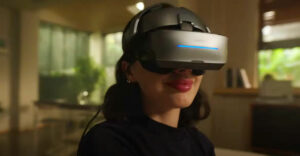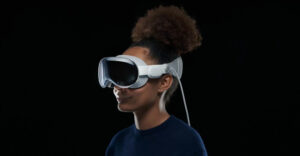Samsung last week began fulfilling orders for its Oculus-power Gear VR headset, giving U.S. consumers their first taste of Oculus VR’s brand of virtual reality. International preorders have opened and have been expanding.
It won’t be until early next year that Oculus VR begins shipping its full-featured Oculus Rift headset, but as a Gear VR collaborator, it has been touting Samsung’s mobile-driven headset.
Like Google’s Project Cardboard, the US$99 Gear VR relies on the processing power of a smartphone. Specifically, it relies on the power of a late-model Samsung handset: a Galaxy Note5, a Galaxy S6, Galaxy S6 Edge or a Galaxy S6 Edge Plus.
The Gear VR is fitted with lens, and it holds the smartphone in place. Oculus VR’s software formats the content for the Galaxy devices’ high-resolution displays.
Over 25 VR games are expected to arrive for Gear VR before the second half of next month. Gear VR supports Oculus VR’s Social alpha, an early build of a VR meeting place that will allow friends — or strangers — to consume content in shared digital space.
Those sick of waiting for VR that won’t make them sick can check out demos of Gear VR in select AT&T and Best Buy stores.
Getting Into Gear: The Reviews
The HTC Vive is due for a soft launch this holiday season, followed by widespread Q1 launch next year. Facebook-backed Oculus VR has scheduled the Oculus Rift for a Q1 release date as well, while Sony’s Morpheus has been tentatively slated for launch in the first half of 2016.
Those are the headsets expected to draw throngs of gamers — the lot considered most likely to carry the industry to the mainstream.
That said, even though Gear VR’s graphical fidelity may be leagues behind the experiences expected next year, a shift already may be taking place.
Geoffrey A. Fowler, for example, has been spending less time in the real world lately.
“You won’t mistake what you see in there for reality — you can clearly make out pixels, like when you’d sit too close to an old tube TV,” he wrote in his review for MarketWatch. “Yet using the Gear VR for a week, I frequently found myself getting wrapped up in its virtual worlds, for longer and longer stretches.”
While noting the struggles of Oculus Rift demos when played on Gear VR, The Verge’s Ben Popper still found himself deeply immersed in the world the mobile headset painted. At times, he might have been too immersed for his liking.
“I was lost in the world and yet, at the same time, terrified that at any moment a real person, waking up and heading for the bathroom or coming to ask for a glass of warm milk, might find me standing alone in the pitch black, shuffling around and grasping at air like a madman,” Popper wrote. “I suddenly yearned for the ability to keep the real world vaguely in the background, a tether to reality.”
Many consumers won’t know what they’re missing out on for now, as the full-fat VR experiences are still months away. However, mobile VR is more than games — and, VR cinema could be the catalyst that turns early adopters into loyalists.
With VR cinema, the viewer is “no longer stuck with whatever the director choose” for the audience, noted Anick Jesdanun in a Gear VR review for The Associated Press.
“Repeat viewings sometimes turned up unexpected detail,” Jesdanun wrote. “Not until a second viewing of a Cirque du Soleil video did I notice performers to my left and right. In a horror video, I initially kept my eyes on a woman in distress; only later did I see scary creatures crawling out of a playground.”
A Fad or a Foundation
There was hype around 3DTVs, and there was hype around Nintendo’s Virtual Boy. Yet Oculus VR has been out to preach the message that VR technologies have taken leaps and bounds.
Gear VR is heralding the return of VR, doing so at a price that’s believed to be at least a third less than the full-featured headsets scheduled to arrive next year.
Cost could be a sticking point for VR in the early legs of its race to the mainstream, according to Rob Enderle, principal analyst at the Enderle Group.
“If you make it cheap, the experience isn’t good enough, and high performance tends to be too pricey,” he told TechNewsWorld.
So the benefits better be worth the asking price, said Larry Chiagouris, professor of marketing at Pace University’s Lubin School of Business.
“The greater the benefits, the more that the cost becomes less of an obstacle,” he told TechNewsWorld. “Samsung will have to prove that this is more than a gimmick for a select few consumers, and that most consumers can benefit from the technology. Thus far, VR has been around a few years now, and the combination of industry players have not yet demonstrated the benefit.”
To make those benefits compelling, all of VR’s elements have to be cooked, noted Enderle. In its current state, the technology is close to being fully baked, but it likely will take at least one more cycle in the oven.
“I actually think the Oculus Rift folks are doing a better job of thinking through all of the elements, but even they need more work on the human interface part of this problem,” said Enderle. “Samsung is basically trying to slipstream them, but in an incomplete way.”
The initial effort looks as if it doesn’t have enough to succeed, in his view. It could even take up to three more cycles before all of the bugs are exterminated and the product is broad-market capable.
“The danger is if this isn’t cooked enough,” Enderle said. “But “If it is marketed well, it could sell well initially, particularly during the holiday season,” Enderle said, but if it’s not cooked enough, it could “bounce, leaving a bad taste in the consumer’s mouth, much like 3D TV recently did, [which] set the market back years.”




















































For some reason technology companies seem to think people are obsessed with 3D and virtual reality experiences? Maybe because they have little else to focus on improving and are desperate to create a new market. We have seen Halolens from Microsoft too which touts great things in 3D development but demo’s a cheesy game environment where monsters jump out from walls. In the end this is more gimmicky and cheesy then actually useful and well developed for practical uses. Its kind of like Google Glasses which were supposed to be the envy of every techy person who wants any kind of tech. Apparently everyone is obsessed with buying anything tech. I think most people now realize just because you can build a device, does not mean it has useful purposes. The Apple Watch also seems too redundant and makes a few more bucks for Apple. But does little for a end user. I guess, if your that lazy you can’t use your smartphone.Then why buy a watch to monitor your walking steps per day? The VR’s marketing is simply to sell more phones, make some bucks off techy addiction syndrome and eventually move on to another worthless piece of tech that will end up on the list of why did they build that list.